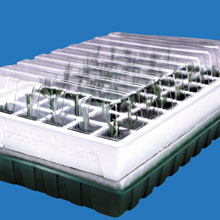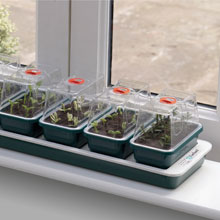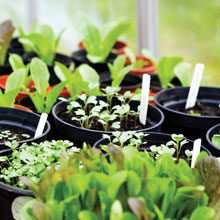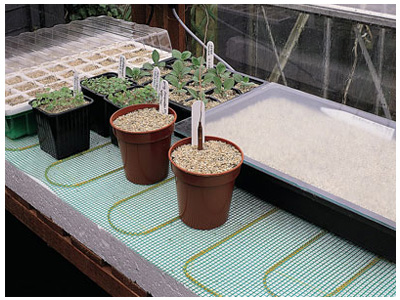
Propagators
Although many seeds are quite capable of germinating without our assistance, greater success can be achieved if we can create ideal conditions in which seeds burst into life. Just as the fork and spade are essential tools of the gardener, a propagator is part and parcel of the seed-raiser's armoury.
In order to germinate from a seed, plants have three basic requirements: moisture, oxygen from the air and adequate temperatures. Not all require light to germinate. These may sound simple enough to provide but at no other time in its life is a plant more vulnerable to changes in the environment than during the process of germination. Young tissues are very fragile and have not yet had any time to build up resistance to sudden changes in temperatures and moistures. Excess of both these basic needs can be as damaging to young plants as if they were not provided at all. If conditions are not right for germination, some seeds will remain dormant until conditions improve, others will perish.
Although plant breeders are currently introducing new varieties and hybrids that are easier to germinate and more uniform in their rate of germination, there is still a vast range of plants offered by seed merchants' catalogues which have a whole spectrum of responses to moisture and temperature. This is obviously determined by the climate they experience in their homelands. Some plants may need only a short period of high temperatures to stimulate germination whilst others may require consistently high temperatures over a long period of time. Others may even need a mixture of high and low temperatures each day in order to grow.
Whatever we grow from seed be it vegetables, bedding plants or something from the depths of a tropical rain forest, seed is valuable. It makes sense to be able to control the conditions affecting germination, tailoring them to the needs of each specific plant rather than leaving it to chance. Propagators enable us to achieve this degree of control. Besides making our hobby more rewarding, sweeping away much of the mystique which surrounds growing plants from seed, they also extend the growing season by providing optimum conditions for growth when the outdoor climate can be least favourable.
Types of propagator
A propagator can be as simple or as complicated as today's technology will allow us to produce. In its simplest form, a propagator can be just a sheet of glass or polythene covering the tops of the seed trays. This cover will prevent seeds from drying out, whilst keeping them slightly warmer than the surrounding air. There is little control and when exposed to the direct rays of the sun, temperatures can quickly rise, killing both seed and seedlings. Excessive condensation can cause rotting.

As light is not required for many plants to germinate, many people place their seeds in the warmth of the airing cupboard (drying closet). Pots and containers can be again covered by polythene to stop the surface of the compost from drying out. The main drawback with this particular method is that seeds need checking daily for signs of germination.
Being left in the dark the young seedlings will soon become drawn and weak. Unable to support themselves they will flop over, affecting their appearance for life. Also a decision must be made when to bring the containers away from the heat and into the light. This may mean sacrificing the first few seedlings while waiting for the majority to appear.
If you are anticipating buying a propagator, then you might as well start off on the right foot by selecting the most appropriate model. The basic design for a propagator is that of a tray with a removable transparent hood or lid. It is in this enclosed space that seeds are germinated. Propagators can also have heating units enabling them to be kept at a constant temperature. However, depending upon the degree of sophistication, these may be ten or more times as expensive as the basic unheated types.
With so many types on the market, you may become confused by the choice. However, to make sense of what's on offer take time to list your needs, such as:
- The range, quantity and type of plants you want to grow
- Other uses besides seed raising, such as rooting cuttings and over-wintering plants
- Where the propagator will be situated i.e. greenhouse or windowsill
- Precisely when in the year and the duration of time that the propagator will be in use.
After weighing up all the factors and matching those with what is available, the final decision will be determined by cost.
A propagator with two separate trays enables you to create two slightly different sets of conditions.
Unheated propagators
Unheated propagators are the simplest and cheapest types on the market. The basic models are usually composed of two components, a tray in which to place compost or pots of seed and a transparent cover which rests on the rim. Sizes vary but most are based on the standard seed tray or half tray. The cheapest are made from thin, flimsy plastic and are ideal for rough use, being cheaply replaced when damaged. The main drawback is that they have no ventilation facility and must be carefully sited out of direct sun. Ventilation may be achieved by propping open one side of the cover.

Slightly more expensive types are constructed from better quality materials such as polypropylene, which does not shatter or break. The larger canopies of many better quality types prevent sudden sharp changes in temperatures and humidity. Most models also have ventilators let into the top to allow air to circulate, whilst reducing high temperatures and humidity. The size of aperture is controlled by either louvres or rotating discs, and by this method the internal environment can be roughly set to the prevailing weather conditions or the needs of the seedlings.
Heated propagators

Up till now, we have only talked about propagators warmed by an external and somewhat uncontrollable heat source. This may be a glasshouse heater, radiator or even sunlight, which during late winter or early spring may be extremely erratic.
The biggest step forward when choosing a propagator is selecting a model which has its own integral source of heat. This allows a greater degree of flexibility and ensures the propagator reaches a steady temperature over a long enough period to stimulate germination in a greater range of plants.
The vast majority of models are powered by electricity which means a mains supply must be located close to where the propagator is to be sited. There are a few types which produce heat by burning fuel oil, such as paraffin.
The heat in electricity powered types is usually provided by warming cables or a heated mat which is located beneath or actually fixed inside the bottom tray. When in operation the heat from the cables or mats is conducted into the pots or compost containing the seeds.
The simplest form of propagator is a small tray with a clear hood which can be used on a windowsill.
The amount of heat produced by the heating system is dependant upon its wattage. Most models will specify their rated wattage. The higher the wattage, the more responsive the heating unit, and its ability to give a swift increase in temperature. As a rule of thumb, when choosing between two identically sized propagators, the one with the highest wattage will be able to maintain the highest constant temperature. This becomes important when running the propagator in unheated surroundings during cold periods. A low wattage model may struggle to produce adequate temperatures for germination than its more powerful counterpart. As you may expect the higher the wattage rating the more expensive the propagator.
Again, as with unheated models, because the heat source is not under such strict control, keep a check on the temperature inside the propagator, ventilating the seedlings during hot spells.
If you want a greater degree of control over the temperature inside your propagator, purchase one which is thermostatically controlled. The beauty of the thermostat is that it allows the heating unit to rise to its pre-determined temperature, then the power is switched off. Once the temperature drops below the minimum, power is restored and the unit heats up again. Besides producing a more even growing environment for your seeds, it also saves power further reducing the cost of heating.
The temperature at which the thermostat operates can either be preset by the manufacturer or it can have the facility of variable control, the temperature being preset by the operator. This is the most sophisticated type and really gives you fine tuning over your growing environment. Most give an adjustable temperature between 45-85F (7-30C), which is adequate for germinating the vast majority of seeds. With many models, the thermostat is located in the base of the propagator next to the heating cables. Some larger and more expensive types however, have a movable temperature probe which can be inserted into a particular seed tray, giving fine temperature control exactly where it is needed. With the advent of computer technology, some manufacturers are installing microchips into their heat regulating devices, further streamlining their design.
Many manufacturers make heated propagators which are subdivided into two or more compartments. These smaller independent growing units allow different seed types to be grown in isolation from each other, allowing inspection of particular seed batches without disturbing the others. Of course the greater the number of compartments, the more expensive the propagator. Certain manufacturers have taken this idea a stage further by producing models which have variable heat control in each separate compartment.
If you prefer growing under one roof, many propagators come with a single large domed lid. These may have extra ventilation facilities such as louvres or even electric fans in expensive models. The larger air space will allow you to grow plants on to larger sizes and may become permanent homes for tricky tropical plants. As part of the kit many manufacturers provide a number of different sized seed trays to fit into their heated bases. If you prefer space sowing, look out for propagators which include cellular inner trays. Once established in their own tiny unit, seedlings can be removed with the minimum of disturbance.
In this range of heated propagators expect to pay about eight to ten times as much for a top of the range model with variable thermostatic control than for a basic single unit model without any form of heat control.
Growing on windowsills
Not everybody has a greenhouse and many people raise plants from seed on windowsills or above radiators. Whilst most standard electric propagators are too large for the average windowsill, a few manufacturers have come to their aid by producing models which are specifically designed for use indoors. Designed along the same lines as conventional types, the windowsill models have their growing compartments lined up end to end on a narrow heated base.
Growing on windowsills means that light is directional, so ensure that the individual units are removable and can be turned round. This will ensure that seedlings are kept growing upright instead of leaning to the light. Prices are competitive, costing the same as an average priced heated model.
Large propagators are for those who are really enthusiastic about propagation or are even considering starting a small nursery! Many models have bases constructed in heavy duty plastic although some are made in aluminium or even timber. Trays are usually reinforced to take the extra weight and sizes vary from about 38 x 22in (1m x 56cm) to 58 x 29½in (1.5m x 75cm), which hold about 12 seed trays. Many are heated by a foil wrapped sheet element, although some use heating cables, rated about 60 to 75 watts. For propagators this size, temperatures are governed by mobile sensors. These are inserted just beneath the compost in your seed trays.

Prices vary tremendously depending upon the power of the heating unit, the size of the propagator and the material it is constructed from.
If you need a large propagating unit it's most economical to make your own using a wooden frame, insulation, sand, heating cable and a thermostat.
Heating mats and cables

If you have to raise a considerable number of plants each year then even a large heated propagator may not be suited to your needs. If a little gentle bottom heat is all that you require you could consider using a heated mat. Once installed, a large amount of pots and seed trays can be started off all at once. The heated pads produce a low but constant heat output but in cold conditions in unheated surroundings they may not be able to maintain temperatures sufficient to germinate seeds. However, this may be enough to grow seedlings on, keeping low temperatures at bay.
The size of mat and wattage of the heating element will determine the running temperature. Those which are covered in foil give a better distribution of heat. To conserve the maximum amount of heat the mat should be laid on a polystyrene sheet.
This may or may not be supplied by the manufacturer. Certain models come with a polycarbonate surround to conserve heat around the seed containers, important if you have a draughty greenhouse!
As an additional extra, variable thermostats are available for certain models. Prices do vary but a reasonable type measuring 15 x 24in (38 x 60cm) rated at 28 watts can be bought for the price of a small heated propagator.
If you really want to produce warm conditions either making a hot bed or even your own propagator, then purchasing a length of soil warming cable and a thermostat is the ideal solution. Cables are laid out about 2in (5cm) apart, looping them around until the area is evenly covered. The ends are then connected to the thermostat. Cable lengths vary from 10 to 268ft (3 to 82m), the longer the cable the higher the wattage and heat output. For instance a 20ft (6m) cable, rated at 75 watts will cover an area 3 x 2ft (90 x 60cm). The cost, including a thermostat, is about the same as a heated propagator with variable thermostatic control. When installing heating cables always follow manufacturers instructions and recommendations. Cables are usually laid in a thick layer of coarse horticultural grade sand. This will heat up and retain heat for a considerable period.
WARNING
Most electrical appliances are completely safe during operation, but occasionally things do go wrong. Many manufacturers install a small bulb in their propagators which is illuminated when the machine is in operation and is receiving power. Make sure that all plugs are properly fused. Before undertaking any installation or repair take professional advice if you are at all unsure.
As an extra precaution, it is wise to install a power breaker into the main plug socket. These inexpensive devices are easy to install protecting both yourself and your equipment should there be any chance of a short circuit or overload.
And remember that with so much water about and probably an aluminium structure to the greenhouse, electrical safety is absolutely vital to prevent damage both to your equipment and, more importantly, harm to yourself.
Sign Up For Exclusive Special Offers




© 2024 Thompson & Morgan. All rights reserved. A division of Branded Garden Products Limited.



